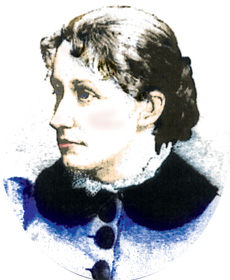Morgan Silver Dollars Collection
The Morgan Dollar Design
America's silver dollar coinage was long overdue for a face-lift, and in 1876, 30‑year‑old Englishman George T. Morgan, new assistant engraver at the Philadelphia Mint, was up to the task. Morgan had studied under the English engraver Leonard Charles Wyon before coming to America.
After an October meeting with US Mint Director Dr. Henry Linderman, Morgan enrolled in the Philadelphia Academy of Fine Arts. He knew the Mint Director wanted the head of Liberty featured on the new silver dollar, a coin that would eventually be called the Morgan dollar, and he needed to learn more about the nation's art. There he met American painter Thomas Eakins.

Anna Williams, model for the Morgan dollar design
Morgan made several studies of Greek profiles, and searched for an American girl to represent the Goddess of Liberty on his silver dollar. Thomas Eakins introduced him to Miss Anna Williams, a schoolteacher. Morgan asked her to pose, and at first, she was reluctant. No respectable lady would model for an artist back then! She insisted on strict secrecy, fearing she would lose her job if the truth got out. Williams sat for Morgan five times, supposedly at Mr. Eakins' home. And by early 1877, George T. Morgan had created the new design that would come to be known as the Morgan dollar.
Some years later, a newspaper reporter discovered the identity of Morgan's Liberty and over protests, printed the story. Williams, as she feared, lost her teaching position. Fortunately, she found another teaching job and remained in Philadelphia until her death in 1926, just five years after the last Morgan silver dollar was minted.
Read more about the history of Morgan Silver Dollars.

The Morgan dollar obverse design depicts Liberty wearing a Phrygian cap.

The reverse features an eagle clutching an olive branch and 3 arrows.
A closer look
The magnificent Morgan dollar was struck from 1878 through 1904, and one final time in 1921. This silver dollar's obverse (heads side) continues the tradition by displaying the classic Liberty profile first used on America's silver dollars from 1794-1804. The Liberty Head, better known as the Morgan dollar design, replaced the long-running Seated Liberty design. It features the head of Liberty, modeled after Anna Williams, facing left, wearing a Phrygian cap. The close-fitting Phrygian cap was originally worn by inhabitants of ancient Phrygia and ex-Roman slaves to show they were free. It has been used on coins of United States, France, and Latin America. The Phrygian cap is encircled with a ribbon inscribed with LIBERTY. A crown of cotton and wheat, staples of the country, decorate the area above the ribbon. Above Liberty's head on the silver dollar, are the words E PLURIBUS UNUM. First used in 1796 on a gold coin, the motto E PLURIBUS UNUM was used on the Great Seal of United States, and is shown on the scroll held in the eagle's beak. E PLURIBUS UNUM means "out of many one" and most likely refers to the unity of the 13 original states. There are 13 stars below Liberty's head – 7 to the left of the date and 6 to the right. The Morgan dollar designer's initial, a single M, is at the base of Liberty's neck.
On the silver dollar's reverse (tails side) is the eagle with its wings spread. Between the eagle's outstretched wings is IN GOD WE TRUST. Across the top of the Morgan dollar's reverse is UNITED STATES OF AMERICA. The eagle holds in its claws both an olive branch and 3 arrows, symbolizing peace and readiness for war. Above the denomination, ONE DOLLAR, is the mint mark and a wreath of laurel. On the ribbon, which ties the laurel wreath, is another M for the designer George T. Morgan.

